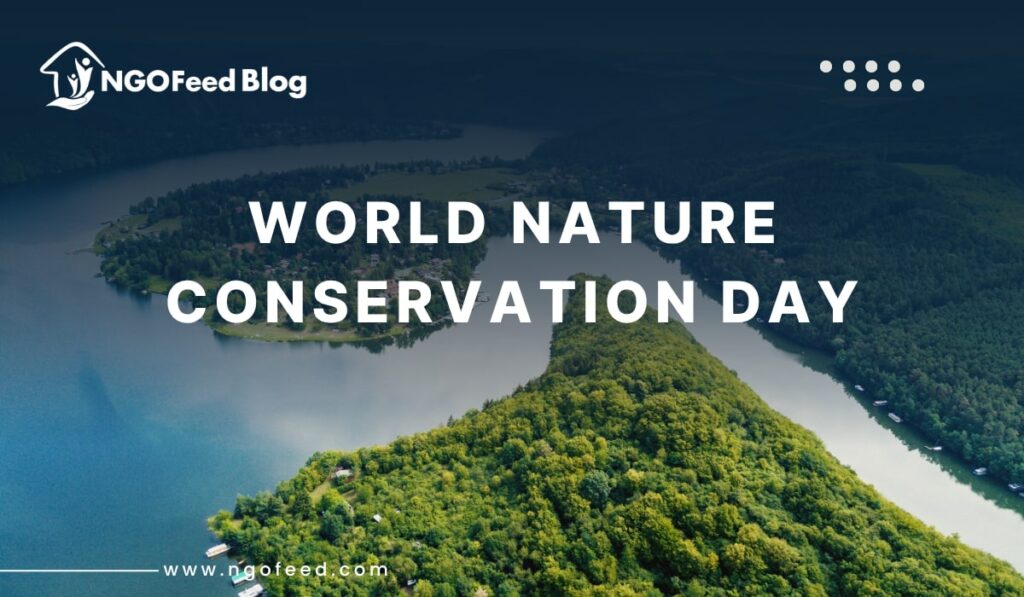Observed yearly on July 28, World Nature Conservation Day reminds us all of our obligation to preserve and protect the natural world for next as well as present generations. The day urges urgent, coordinated action to protect the earth’s limited resources in an age defined by climate catastrophes, biodiversity loss, deforestation, and growing pollution. It acknowledges the interdependency of humans and nature and stresses the need for sustainable development and environmental protection to walk hand in hand.
The importance of this celebration has never been more pressing as we get closer to World Nature Conservation Day 2025. From the melting of glaciers and severe storms to habitat collapse and species extinction, environmental problems are quickening across the world; hence, educated, moral, and inclusive environmental stewardship is at the front of international discussion. The topic of this year, which should center on “Restoration, Resilience, and Responsibility,” will highlight the need to rehabilitate natural habitats, create sustainable resilience against environmental deterioration, and urge every person, organization, and country to take responsible actions toward ecological balance.
Also Read: Role of UNESCAP in India
Often spearheaded by environmental groups, youth groups, schools, and NGOs, educational campaigns, clean-up projects, afforestation initiatives, and policy discussions define the day. For governments and international organizations, it is also a moment to review their conservation pledges, assess how far they have gone toward achieving global targets including the Paris Agreement and the UN Sustainable Development Goals (SDGs), and raise public consciousness for a greener future.
We examine in this essay the origin and historical development of World Nature Conservation Day, go over its 2025 theme and objectives, consider the need of ecological balance, and emphasize how NGOs in India, communities, and policymakers can help to create a society of conservation that will resist time.
Table of Contents
World Nature Conservation Day – Significant
- Healthy ecosystems are essential for human survival.
- Overexploitation has caused habitat loss, species extinction, pollution, and climate change.
- Conservation advances biodiversity, sustainable livelihoods, and climate resilience.
- Encourages balancing growth with environmental preservation.
Background
Celebrated all around on July 28 annually, World Nature Conservation Day aims mostly at raising awareness on the need of preserving and protecting the natural environment. Though the exact beginnings of the day remain unofficial and not ascribed to a single global statement, its spirit is grounded in the increasing worldwide agreement that environmental degradation presents one of the most major threats to human life, biodiversity, and sustainable development.
Also Read: Role of UNHRC in India
Early in the 2000s, as environmental awareness started to dominate governmental policy, academic debate, and civil society activity, World Nature Conservation Day gained momentum. Rising proof of global warming, habitat degradation, species extinction, and overexploitation of natural resources mostly drove this. Stronger conservation ethics were championed by governments, international agencies, and nonprofits beginning to call for it, therefore stressing the need of restoring ecosystems and advancing sustainable consumption patterns.
This day has developed over time into a symbolic call to action urging people, societies, businesses, and legislators to rethink their connection with the natural environment. Especially Goal 13 (Climate Action), Goal 14 (Life Below Water), and Goal 15 (Life on Land), it provides a venue to contemplate the advancement achieved under global environmental frameworks including the United Nations Framework Convention on Climate Change (UNFCCC), the Convention on Biological Diversity (CBD), and the Sustainable Development Goals (SDGs).
The roots of this celebration also strongly relate to indigenous knowledge, traditional ecological knowledge, and the part of grassroots movements in defending forests, rivers, and wildlife. Because of its great biodiversity and decades of conservation customs based on spiritual, cultural, and community-based traditions, the day has more meaning in nations like India.
Also Read: Role of WFP in India
World Nature Conservation Day therefore reminds us that protecting the earth is a moral and group duty rather than simply a technical one. As we approach 2025, with the climate clock ticking and ecosystems under duress, the backdrop of this day calls us beyond symbolic motions to ongoing, scientific, inclusive environmental action.
World Nature Conservation Day 2025 theme: “Restoration, Resilience & Responsibility”
The theme suggested for World Nature Conservation Day 2025 “Restoration, Resilience and Responsibility,” perfectly describes the urgent, linked measures required to tackle the environmental catastrophe of Earth:
Stresses the need to restore damaged ecosystems through tree planting, stream rehabilitation, and restoration of soil quality. It’s a deliberate investment in nature’s ability to revitalize and preserve biodiversity, not just nostalgic.
Also Read: Role of UNAIDS in India
Concentrates on building ecosystems and communities to survive biodiversity loss and climate extremes. Resilient is developed via adaptive conservation techniques including urban green infrastructure, animal corridors, and climate-smart agriculture.
Emphasizes the common responsibility of people, businesses, governments, and civil society to act honestly from lowering trash and embracing sustainable manufacturing to honoring indigenous land management and advancing environmental justice.
Why This Theme Counts
Linking ethics (responsibility), readiness (resilience), and action (restoration), the holistic approach produces a thorough plan for ecological management
Community-Focused: It recognizes that resilient environments need committed communities—local as well as worldwide.
Offering particular goals for governments, NGOs, and businesses, the topic relates to the UN’s Sustainable Development Goals—especially SDG 13 (Climate Action), SDG 14 (Life Under Water), and SDG 15 (Life on Land).
Under this topic, we are asked to roll up our sleeves as we observe World Nature Conservation Day 2025 rather than simply consider what has been lost. Together, we may restore ecosystems, foster resilience in people and planet, and accept stewardship responsibility for a sustainable future.
Also Read: Role of UNODC in India
How is World Nature Conservation Day Marked
From local projects to high-level policy discussions, World Nature Conservation Day is celebrated all over in a broad spectrum of ways. The day acts as a call to coordinated activity among governments, NGOs, universities, civil society, and people; it is not only symbolic tribute. This is commonly indicated as follows:
1. Awareness Campaigns and Educational Programs
Seminars, nature hikes, eco-quizzes, poster-making competitions, and workshops emphasizing environmental literacy are among the events schools, colleges, and universities sponsor. These activities intend to instill environmental awareness among young people and to stimulate critical thought about conservation problems and ideas.
2. Campaigns for cleanup and tree planting drives
Leading big-scale tree planting projects—especially in urban or degraded regions—are NGOs, forest agencies, and local environmental organizations. Organizing beach clean-ups, lake rehabilitation initiatives, and removal of solid trash from natural habitats also engages local people directly in conservation efforts.
Also Read: Role of UNEP in the Environment
3. Environmental Summits and Policy Dialogues
Often using the day to debut fresh environmental initiatives, publish biodiversity reports, or reaffirm pledges to world sustainability objectives, governments and international bodies. Scientists, campaigners, and legislators get together during roundtable meetings, seminars, and think-tank sessions to address urgent environmental challenges.
4. Media Contact and Online Campaigns
With influencers, environmentalists, and organizations posting messages, infographics, and short films to increase public participation, hashtags like #NatureConservationDay see a rise in social media campaigns. Documentaries, blogs, and podcasts highlighting conservation stories are also released.
5. Corporate Environmental Programs
Environmentally conscious companies seize this chance to emphasize green business methods including carbon offsetting, plastic reduction, sustainable sourcing, or employee-led conservation efforts. Some also engage in corporate social responsibility initiatives in partnership with NGOs for biodiversity conservation or forestation.
6. Indigenous Involvement and Community
Local activities define the day with community-based conservation initiatives, especially in woodland and rural areas. Indigenous leaders frequently highlight the cultural aspect of nature preservation and share traditional ecological knowledge.
Also Read: Role of NGOs in Economic Development
World Nature Conservation Day reminds us to integrate sustainability into daily living whether by tree planting, plastic reduction, policy support for ecologically friendly products, or other means. Everyone has a role in sustaining the earth.
Reminder
Submit your documentation by 20 July 2025 to your regional environmental department or eco-club leaders if you are planning events or projects.
Conclusion
As we commemorate World Nature Conservation Day 2025, we are reminded that preserving nature is an existential necessity rather than an optional goal. Faced with rising climate disturbances, shrinking biodiversity, and overused ecosystems, the call for restoration, resilience, and responsibility has never been louder or more crucial. This day offers a worldwide milestone to think back, rededicate, and align our deeds with the ideals of environmental justice and sustainability.
Though governments and international organizations play a vital role in implementing strong environmental laws, actual power resides in collaborative grassroots action. NGOs, neighborhood groups, schools, companies, and individuals must work together to cultivate an ecological awareness that goes beyond observations and into daily life.
Every action counts, from tree-planting initiatives to climate education, indigenous stewardship to youth innovation. Let World Nature Conservation Day 2025 be a catalyst—not only for symbolic celebration—but also for actual, quantifiable advancement toward a greener, fairer, and more sustainable Earth for next generations.
We can together preserve and reclaim the natural environment supporting us all by wise acts and collective accountability.
Sample Address for World Nature Conservation Day 2025
Dear friends, teachers, students, and respected headmaster,
Celebrating World Nature Conservation Day today, we gather to appreciate the worth of our limited natural resources. Life on Earth depends on our forests, rivers, air, and earth. Still today, however, neglect, excessive consumption, and pollution endanger them.
Conservation is now a need rather than an option. Our next generations will inherit a world in peril if we fail to conserve nature. Responsible world citizens have to start living sustainable lifestyles daily, preserve resources, and safeguard biodiversity.
Also Read: Role of UNWTO in Tourism
Let us cut trash, save water, grow more trees, and spread awareness about the value of a pristine environment. Every little action made today helps to create a more robust, greener future.
Let’s vow to save our only home—our Earth—on this World Nature Conservation Day.
Thanks!
World Nature Conservation Day Quiz
When is World Nature Conservation Day observed?
28 July
What is the main aim of this day?
To raise awareness about conserving natural resources and protecting the environment
Name any one United Nations Sustainable Development Goal linked to nature conservation.
Goal 15: Life on Land
Why is biodiversity important?
It supports healthy ecosystems that are vital for human survival
Give an example of a sustainable practice.
Using cloth bags instead of plastic bags
What is afforestation?
Planting trees in areas that were not previously forested
Name a major threat to nature.
Deforestation
Which global treaty works for protecting endangered species?
CITES (Convention on International Trade in Endangered Species)
What is meant by ecosystem restoration?
Reviving degraded or damaged ecosystems to a healthy state
What is the suggested theme for 2025?
Nature Restoration for a Resilient Future



